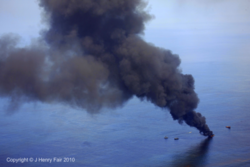New air data analysis shows ongoing public health threat from Gulf oil disaster
 A new analysis of federal air quality monitoring data from Louisiana released today by an environmental watchdog group shows continuing public health threats from the BP oil disaster.
A new analysis of federal air quality monitoring data from Louisiana released today by an environmental watchdog group shows continuing public health threats from the BP oil disaster.A significant number of collected air samples found levels of oil-related pollution that exceeded health-based standards set by the U.S. Agency for Toxic Substances and Disease Registry, a division of the Centers for Disease Control and Prevention. The analysis was done by the Louisiana Bucket Brigade, a nonprofit that helps communities monitor petrochemical pollution.
Among the most troubling findings were the repeatedly high benzene levels throughout the region. For example, on four of the 10 days that the Environmental Protection Agency measured ambient benzene levels using a special monitoring bus, more than 10% of the samples exceeded the ATSDR standard of 3 parts per billion. Benzene, which is known to cause cancer, is found in crude oil.
"This is significant and warrants more sampling to determine the source of the pollution," the report states.
However, the analysis points out that the readings are complicated by the fact that most of the monitoring took place along a highway, which "clouds identification of the source." It calls for the EPA monitoring bus to spend more time on smaller roads with less traffic, and to conduct follow-up sampling when high readings are found.
The data also found elevated levels of hydrogen sulfide, which can cause eye and respiratory irritation, headaches, irritability, fatigue, poor memory, dizziness and reproductive health problems. The problem was particularly serious in the area around Venice in Louisiana's Plaquemines Parish.
The ATSDR's intermediate health standard for hydrogen sulfide is 0.02 parts per million, or 2 parts per billion. On the days when the chemical was detected, its average level exceeded that standard by a factor of 10, while its highest detected levels exceeded it by 60 times. The EPA is currently investigating the elevated levels of hydrogen sulfide in the Venice area.
In addition, the analysis found elevated levels of particulate matter, which can trigger asthma in sensitive people. It also raised concerns that there is not as much monitoring for PM 2.5 as for PM 10, when PM 2.5 is recognized as more harmful and more likely to be produced by burning crude oil. (For more on the PM classification scale, click here.)
The Louisiana Bucket Brigade made a number of recommendations in its report -- including calling for more air monitoring.
"EPA can't be everywhere," says Anne Rolfes, the group's director. "But you have a lot of fishermen, oystermen and shrimpers who are out of work. They know the environment. They should be trained to help with sampling."
To read the full analysis, which includes tables of the findings, click here [pdf].
(Photo of burning oil from the BP Deepwater Horizon disaster by J. Henry Fair, shot during a June 15 flyover with SouthWings. To see more of Fair's aerial photographs of the Gulf oil disaster, click here.)
Tags
Sue Sturgis
Sue is the former editorial director of Facing South and the Institute for Southern Studies.
